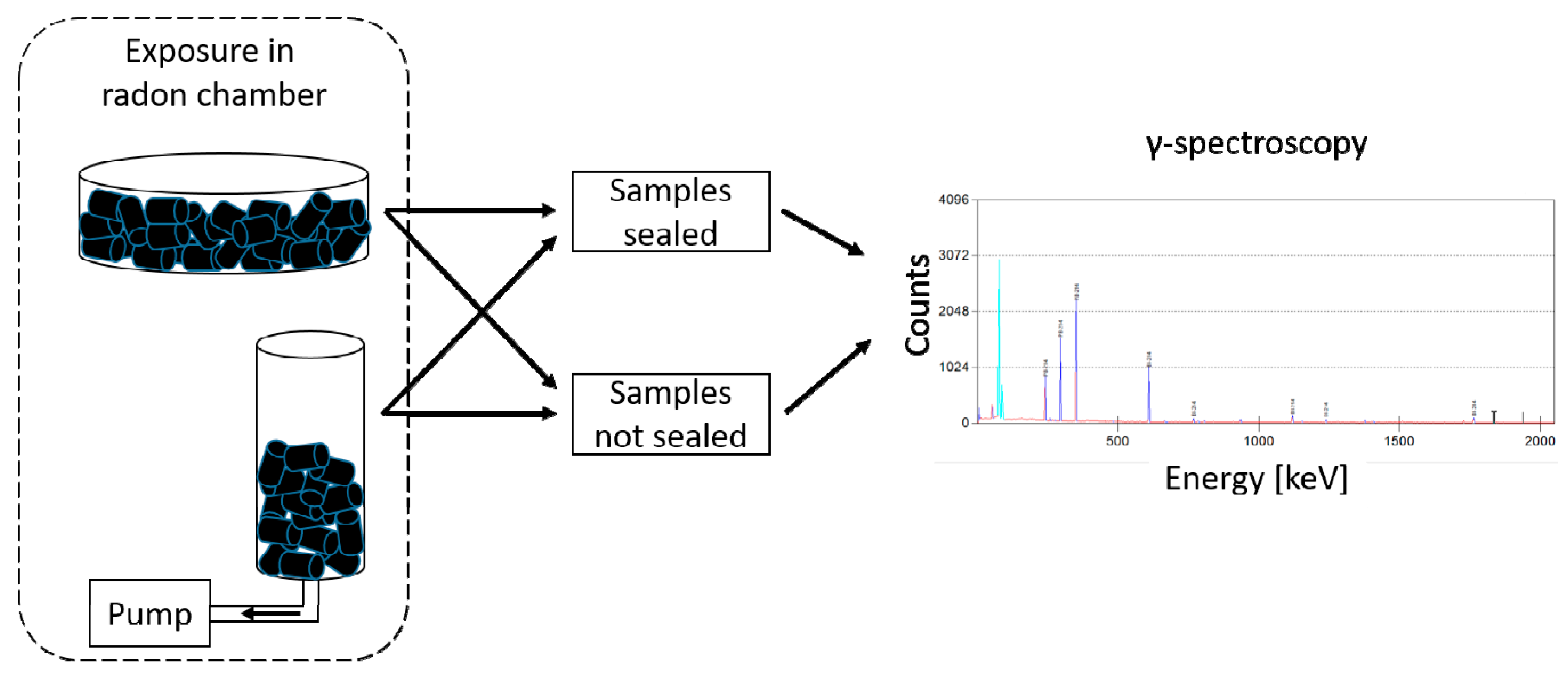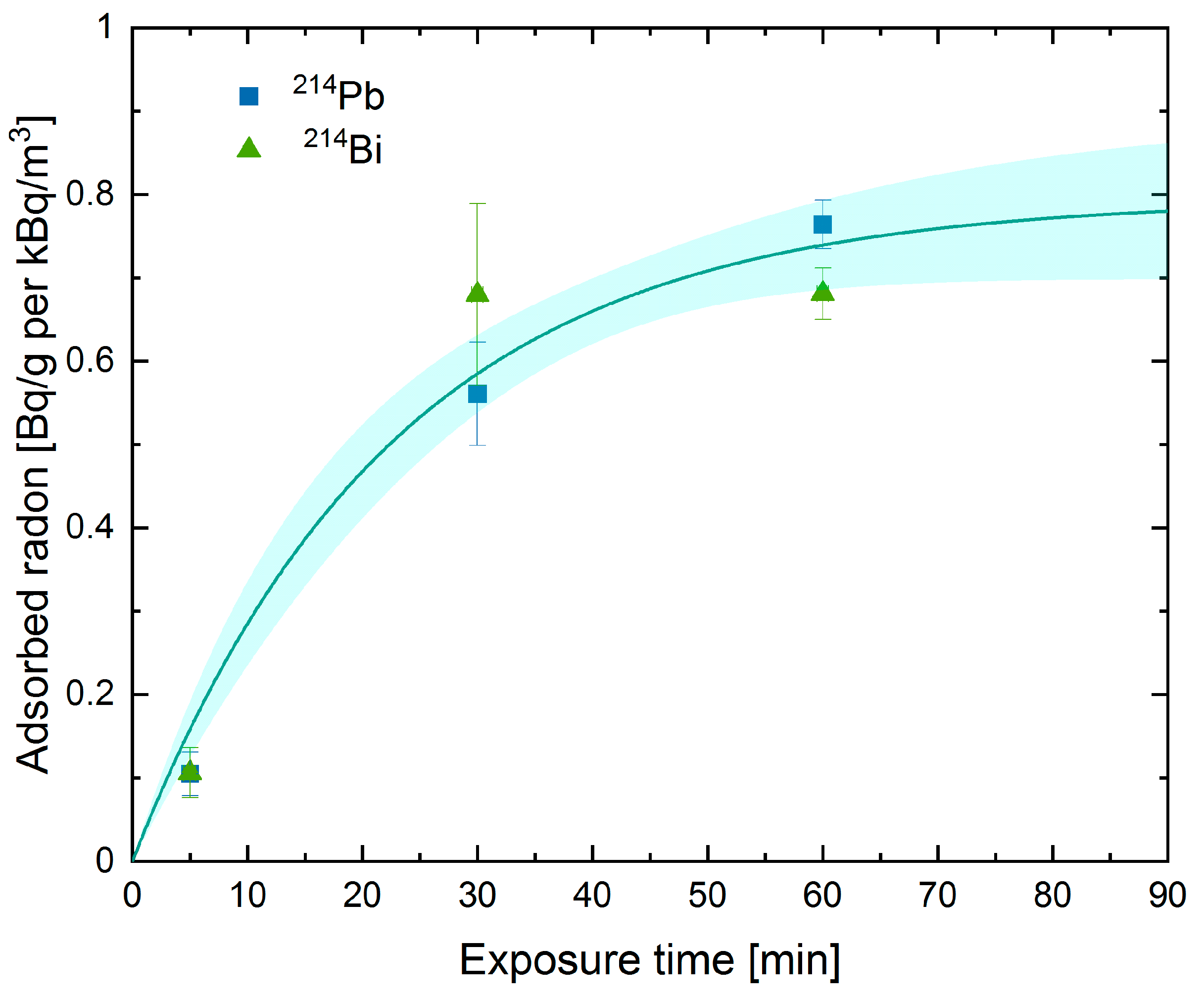Radon Adsorption in Charcoal
Abstract
:1. Introduction
2. Materials and Methods
- Saturation: A distinct amount of charcoal (6.0 ± 0.1 g) was exposed for 5, 30 and 60 min in the radon chamber. The charcoal was placed in a Petri dish with a diameter of 5.4 cm and a height of around 1 cm (number of samples: n = 3).
- Humidity: In order to study the possible influence of the humidity during experiments, charcoal was exposed for 1 h either in a Petri dish or in a small cylinder with an active airflow through the sample at different relative humidity levels ranging from 5 to 94% (n = 14).
- Effective half-life: To explore the transport of radon out of charcoal during our measurements, samples were exposed for 1 h and transferred into another open container (n = 14). Afterward, measurements, as described above, took place. The radon activity in our sample can be described by the following equation:
- Bound radon: To determine the amount of radon bound to charcoal, samples were exposed in a small cylinder with an active airflow (n = 6). Afterward, the samples were sealed and measured as described before. From the determined initial activities, the number of radon atoms bound to charcoal per unit mass could be calculated. In parallel, the number of radon atoms inside the radon chamber could also be calculated. With this, the percentage of bound radon per unit sample mass could be determined. The same measurement procedure was done for the most abundant fatty acids in the human body, namely oleic acid and linoleic acid, and for isotone solution (0.9% NaCl) for comparison reasons [11].
3. Results
3.1. Saturation
3.2. Humidity
3.3. Effective Half-Life
3.4. Bound Radon
4. Discussion
5. Conclusions
Author Contributions
Funding
Institutional Review Board Statement
Informed Consent Statement
Data Availability Statement
Acknowledgments
Conflicts of Interest
References
- Porstendörfer, J. Properties and behaviour of radon and thoron and their decay products in the air. J. Aerosol Sci. 1994, 25, 219–263. [Google Scholar] [CrossRef]
- ICRP. Occupationsl intake of radionuclides: Part 3. ICRP Publication 137. Ann. ICRP 2017, 46. [Google Scholar] [CrossRef]
- Tollefsen, T.; Cinelli, G.; Bossew, P.; Gruber, V.; De Cort, M. From the European indoor radon map towards an atlas of natural radiation. Radiat. Prot. Dosim. 2014, 162, 129–134. [Google Scholar] [CrossRef] [PubMed] [Green Version]
- World Health Organization. WHO Handbook on Indoor Radon: A Public Health Perspective; World Health Organization: Geneva, Switzerland, 2009. [Google Scholar]
- Rabago, D.; Celaya, S.; Fernandez, A.; Fernandez, E.; Quindos, J.; Pol, R.; Cinelli, G.; Quindos, L.; Sainz, C. Intercomparison of indoor radon measurements under field conditions in the framework of metroradon european project. Int. J. Environ. Res. Public Health 2020, 17, 1780. [Google Scholar] [CrossRef] [PubMed] [Green Version]
- Wilson, O.J. Radon transport in an activated charcoal canister. Nucl. Instrum. Methods Phys. Res. Sect. A Accel. Spectr. Detect. Assoc. Equip. 1989, 275, 163–171. [Google Scholar] [CrossRef]
- Ronca-Battista, M.; Gray, D. The influence of changing exposure conditions on measurements of radon concentrations with the charcoal adsorption technique. Radiat. Prot. Dosim. 1988, 24, 361–365. [Google Scholar] [CrossRef]
- Arafa, W. Permeability of radon-222 through some materials. Radiat. Meas. 2002, 35, 207–211. [Google Scholar] [CrossRef]
- Alharbi, S.H.; Akber, R.A. Radon-222 activity flux measurement using activated charcoal canisters: Revisiting the methodology. J. Environ. Radioact. 2014, 129, 94–99. [Google Scholar] [CrossRef] [PubMed]
- Maier, A.; van Beek, P.; Hellmund, J.; Durante, M.; Schardt, D.; Kraft, G.; Fournier, C. Experimental setup for radon exposure and first diffusion studies using gamma spectroscopy. Nucl. Instrum. Methods Phys. Res. Sect. B Beam Interact. Mater. At. 2015, 362, 187–193. [Google Scholar] [CrossRef]
- Sanjon, E.P.; Maier, A.; Hinrichs, A.; Kraft, G.; Drossel, B.; Fournier, C. A combined experimental and theoretical study of radon solubility in fat and water. Sci. Rep. 2019, 9, 10768. [Google Scholar] [CrossRef] [PubMed]
- Elío, J.; Cinelli, G.; Bossew, P.; Gutiérrez-Villanueva, J.L.; Tollefsen, T.; De Cort, M.; Nogarotto, A.; Braga, R. The first version of the Pan-European Indoor Radon Map. Nat. Hazards Earth Syst. Sci. 2019, 19, 2451–2464. [Google Scholar] [CrossRef] [Green Version]
- Tsapalov, A.; Kovler, K.; Miklyaev, P. Open charcoal chamber method for mass measurements of radon exhalation rate from soil surface. J. Environ. Radioact. 2016, 160, 28–35. [Google Scholar] [CrossRef] [PubMed]
- Miles, J. Temporal variation of radon levels in houses and implications for radon measurement strategies. Radiat. Prot. Dosim. 2001, 93, 369–375. [Google Scholar] [CrossRef] [PubMed]
- Nussbaum, E.; Harsh, J.B. Radon solubility in fatty acids and triglycerides. J. Phys. Chem. 1958, 62, 81–84. [Google Scholar] [CrossRef]



| Sample | Nsample(g−1)/Nchamber [%] |
|---|---|
| Charcoal | (2.83 ± 0.42) |
| Linoleic acid | (7.98 ± 1.93) × 10−2 |
| Oleic acid | (5.60 ± 0.61) × 10−2 |
| Isotone solution (0.9% NaCl) | (8.19 ± 1.20) × 10−4 |
Publisher’s Note: MDPI stays neutral with regard to jurisdictional claims in published maps and institutional affiliations. |
© 2021 by the authors. Licensee MDPI, Basel, Switzerland. This article is an open access article distributed under the terms and conditions of the Creative Commons Attribution (CC BY) license (https://creativecommons.org/licenses/by/4.0/).
Share and Cite
Maier, A.; Jones, J.; Sternkopf, S.; Friedrich, E.; Fournier, C.; Kraft, G. Radon Adsorption in Charcoal. Int. J. Environ. Res. Public Health 2021, 18, 4454. https://doi.org/10.3390/ijerph18094454
Maier A, Jones J, Sternkopf S, Friedrich E, Fournier C, Kraft G. Radon Adsorption in Charcoal. International Journal of Environmental Research and Public Health. 2021; 18(9):4454. https://doi.org/10.3390/ijerph18094454
Chicago/Turabian StyleMaier, Andreas, Jesse Jones, Sonja Sternkopf, Erik Friedrich, Claudia Fournier, and Gerhard Kraft. 2021. "Radon Adsorption in Charcoal" International Journal of Environmental Research and Public Health 18, no. 9: 4454. https://doi.org/10.3390/ijerph18094454






